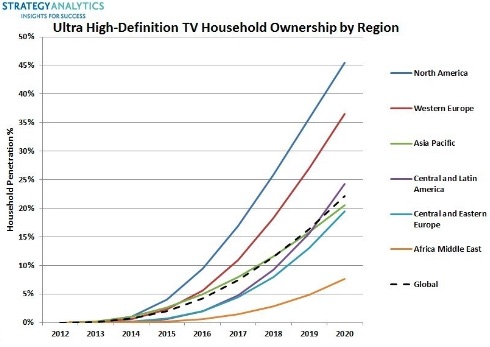I’ve often written on the Nanosys blog about the chicken and egg problem that exists between content creators, broadcasters and display makers. When it comes to next generation UHD video features like 4k resolution, wide color gamut and High Dynamic Range (HDR) these three groups have had a hard time agreeing.

Netflix says they’re shooting 10 new series this year in 4K with HDR and wide color gamut. Marco Polo, the first of these new series, takes full advantage of the new features with its setting in the rich, colorful world of 13th century China.In the past, we’ve seen each side taking a wait-and-see approach with creators and broadcasters waiting to see more capable displays in the market while display makers looked for more content to become available before making compatible screens. That dynamic now appears to be changing rapidly, fueled by growth in China, changes in the way we consume content and the emergence new display technologies.
Even just a year ago, with memories of the slow, painful for early adopters, and ultimately government mandated adoption of HDTV still fresh, there seemed to be little incentive for anyone to break that impasse. Afterall, there would not soon be another nudge from the government, like the switch from analog to digital broadcast, and cable providers are notoriously slow to change (ever notice how your channel guide looks the same as it did in 1998?). So, even as display makers began shipping their first UHD-capable sets, it looked as though adoption of UHD could be in for an even longer slog to the mainstream than HD.
Then China happened and things started to move fast.
Driven mostly by sales in China, shipments of UHD TVs grew an amazing 633% in last year to over 12 million units. Chinese TV manufacturers looking for an edge were suddenly cranking out sub-$1,000 UHD sets, making the technology more accessible to more people faster than almost anyone predicted.
Still, the impasse might not have broken without a couple of other technology-driven changes in the market. A new, “over-the-top” direct content distribution model is enabling consumers to access full UHD content today while new hardware in the form of both content creation tools and display technologies are bringing the viewing experience to life.
Distribution Dynamics
Content distribution is changing rapidly. HBO now offers its service “over-the-top,” or without a cable subscription, and companies like Netflix and Amazon are creating dozens of new shows for direct distribution to consumers through their own channels. So, while the broadcast cable middle-man is still there for most of us, millions of TV viewers now get their content directly from the content creators themselves.
The incentives are totally different for these over-the-top distributors. They’re able to efficiently serve even a small population of early adopters by delivering content on a one-to-one basis. This means they can offer premium quality content to customers who want to pay for it without having to make costly or complex changes to a legacy broadcasting backbone. According to Netflix’s chief product officer, Niel Hunt:
“If you’re a broadcaster or a cable operator, it’s very hard to imagine upgrading to HDR or 4k until there are enough televisions at the other end to be able to receive it. You have to allocate channels, you have to allocate new decoders and all the rest of it. Netflix, because we’re delivering one-to-one, has the capability to deliver even to a very sparse number of users.”
Capture and Display
UHD means more than just 4k resolution. It’s now possible for content creators to capture more colorful, dynamic and lifelike images than ever before with powerful production tools like the ARRI Alexa SXT camera. At the same time new display technologies like quantum dots make it possible to actually see everything that these cameras can capture in our living rooms. We saw a preview of what this looks like at CES this year with nearly every new set from the top brands offering all the immersive UHD features from 4k to wide color gamut to HDR.
The combination of these features offers much more than another incremental improvement in image quality. All of a sudden, or the first time in quite a while, the difference between the TVs consumers have in their living rooms and the new sets at their local Best Buy is dramatic.
Here Comes the Content
As a result, content creators are beginning to respond with new content that takes advantage of all the new features UHD TV sets have to offer and they’re moving fast too. Just last year Netflix was among the first companies to deliver 4k content to your home with House of Cards. A year later they say they’ve already started shooting ten new TV series in full UHD with both wide color gamut and HDR.
 UHD TV Household Ownership. Source: Strategy Analytics
UHD TV Household Ownership. Source: Strategy Analytics
So the impasse is starting to look more like a virtuous cycle with content availability driving interest in upgrades from last-generation flat panels and premium display features showing-off just how great that content can look. Shipments of UHD sets are now expected to double this year and we may see nearly half of US households owning an UHD TV by the year 2020 according to research firm Strategy Analytics. That’s just incredibly fast when you look at the adoption of HDTV which saw it’s first sets ship in the late 90’s and took around 10 years to reach 50% of US households. – Jeff Yurek

